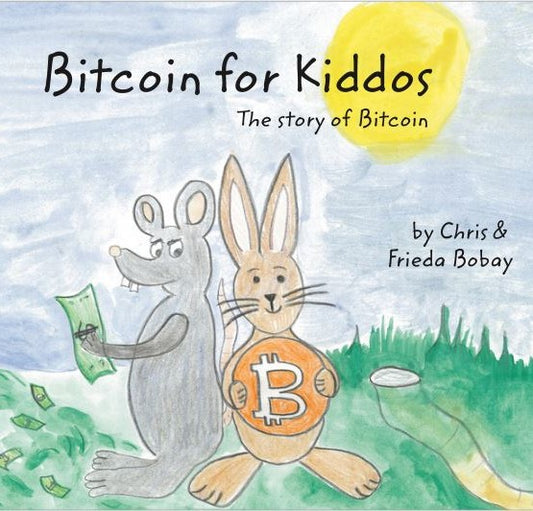Learn More

Bitcoin - The first cryptocurrency ever invented. It was created in 2008 by a pseudonymous programmer named Satoshi Nakamoto. It leverages the groundbreaking technology of triple entry bookkeeping. This invention makes the current banking system obsolete and puts the power of a person's wealth back in their own hands. Find the Bitcoin whitepaper here.
Blockchain - A digital ledger of all transactions on the Bitcoin network. Every ten minutes a new block is created listing all the immutable transactions that took place during that time on the network.
Node - Trust but verify. Bitcoin is a peer-to-peer currency that is regulated by a network of nodes. A node is simply a computer that runs the Bitcoin software. Bitcoin nodes send and receive transactions with other nodes in the network and verify their validity. Bitcoin nodes cooperate with Bitcoin miners to maintain the integrity of the system. Learn how to run your own node.
Miners - The Bitcoin network uses Proof of Work (POW) to create each block. Computers around the world work to solve a very complex mathematical puzzle. The first computer to solve the puzzle is awarded with newly minted Bitcoin, plus network transaction fees and gets its “block” entered into the blockchain.
Difficulty Adjustment - Bitcoin blocks are created on average every 10 minutes. As more miners come online (increasing the hash rate) to compete for newly minted Bitcoin the network must increase the complexity of the puzzle being solved in order to maintain this 10 minute period. This adjustment is made every 2 weeks. Conversely, if the number of miners falls over this 2 week period the puzzle will get easier.
Think of it this way, if you’re solving a puzzle by yourself the network will figure out how many pieces to make the puzzle so it takes you 10 minutes to complete. If 100 people are working on the puzzle the network will increase the amount of pieces to maintain the 10 minute time frame.
Hash Rate - The amount of computational power that is being used to solve the “Bitcoin Puzzle.”
4 Year Halving - Every 4 years the amount of newly minted Bitcoin for each block is cut in half. This has a deflationary effect therefore creating scarcity. This scarcity has had the effect of increasing the value of each bitcoin through a basic economics concept known as “Supply and Demand.”
Self Custody - The bitcoin network allows each user to have what is called a “Cold Storage” wallet. This is where the term “not your keys, not your coins” comes from. The Bitcoin network has never been hacked, however businesses holding Bitcoin on behalf of clients have. It is like holding the passcode to your own safe. Once you give up the code to a 3rd party there is a chance that your safe will be accessed by others.
Cold Storage Wallet - A digital wallet that holds your Bitcoin and is not connected to the internet. The user has personal custody of their private keys. This could either be a computer or a USB flash drive that is not connected to the internet.
Hot Wallet - A digital wallet that is stored online and secured by a third party custodian like an exchange or bank. The third party holds the private keys. This is the riskiest way to store your Bitcoin because if the third party gets hacked, then your Bitcoin becomes at risk of being stolen.
Bitcoin Exchange - A place where you can buy and sell Bitcoin on the open market 24/7/365.
Lightning Network - A secure payment system built on top of the Base Layer Bitcoin blockchain. Allows for cost efficient micropayments at the speed of light; with near instant settlement making it possible to purchase day to day items like coffee, gas, or groceries without having to wait the typical 10 minute settlement time on the base layer.
Public & Private Keys - In order for a transaction to be valid on the Bitcoin blockchain a user must match a set of Public and Private keys.
Think of it this way: Each dollar bill has a serial number on it. If the dollar only has half of the serial number visible (Public Key) the dollar isn’t valid. The owner of the dollar has the other half of the serial number (Private Key). The owner would only add the other half when they are ready to spend it. It works like an encrypted signature. If someone else tried to spend that dollar it wouldn’t work because the serial number would not be correct.
HODL - Buy and Hold long term. Never Sell for short term gains. A sovereign individual's best protection against price volatility and the excessive printing of fiat currency. Dollar Cost Average your way to prosperity.
The Rabbit Hole - The educational journey of understanding money and living a life of independence and self sovereignty. Remember, you don’t change Bitcoin… Bitcoin changes you.
Additional Resources:
Get started at Hope.com
Listen to:
Orange Pill Podcast
The Break Down Podcast
The Investors Podcast
The Bitcoin Standard Podcast
What Bitcoin Did Podcast
Shop Our Books
-
Bitcoin for Kiddos Book
Vendor:BTC PublishRegular price $14.95 USDRegular priceUnit price per -
99 Signs you Might be a Bitcoin Maximalist Book
Vendor:BTC PublishRegular price $12.95 USDRegular priceUnit price per -
Bitcoin Book Bundle (2 books total)
Vendor:BTC PublishRegular price $25.00 USDRegular priceUnit price per$27.90 USDSale price $25.00 USDSale



